About a quarter of U.S. adults regularly watch religious services online; 21% use apps or websites to help with reading scripture
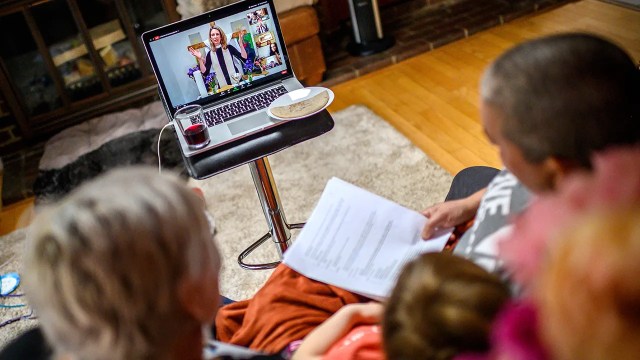
Pew Research Center conducted this survey to explore how Americans use technology in their religious lives. For this report, we surveyed 11,377 U.S. adults from Nov. 16-27, 2022. All respondents to the survey are part of Pew Research Center’s American Trends Panel (ATP), an online survey panel that is recruited through national random sampling of residential addresses. This way nearly all U.S. adults have a chance of selection. The survey is weighted to be representative of the U.S. adult population by gender, race, ethnicity, partisan affiliation, education, religious affiliation and other categories. For more, see the ATP’s methodology and the methodology for this report.
Read the questions used in this report.
About a quarter of U.S. adults regularly watch religious services online or on TV, and most of them are highly satisfied with the experience, according to a new Pew Research Center survey.
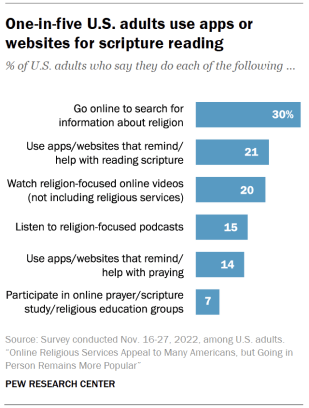
The survey also asked about other uses of online technology, like apps and websites, for religious purposes. Key findings include:
- 30% of U.S. adults say they go online to search for information about religion.
- 21% use apps or websites to help them read the Bible or other religious scriptures.
- 15% listen to religion-focused podcasts.
- 14% use apps or websites to help or remind them to pray.
The survey of more than 11,000 U.S. adults was conducted in November 2022, well after the height of the coronavirus pandemic but before the Centers for Disease Control and Prevention declared an end to the COVID-19 public health emergency.
It’s been clear for more than two years that the video technology that helped Americans stay in touch with relatives, friends and colleagues during COVID-19 lockdowns was also helping many to connect with houses of worship. From kitchens or living rooms, in their Sunday best, pajamas or something in between, those with an internet connection and a screen could pray along with other virtual attendees, listen to sermons, and sing along with choirs, all in real time.
What wasn’t clear, though, was how people felt about these virtual experiences. Would they keep watching services on screens, even after they thought it was safe to attend in person? What did they like about joining services remotely? What didn’t they like? The survey was designed to explore these kinds of questions.
Broadly speaking, the survey finds that most Americans who watch religious services on screens are happy with them. Two-thirds of U.S. adults who regularly stream religious services online or watch them on TV say they are either “extremely satisfied” or “very satisfied” with the services they see.
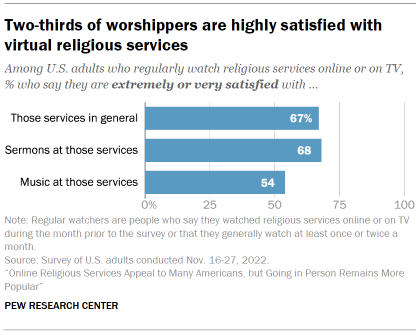
Similar shares express satisfaction with the sermons they hear during virtual services. In addition, a little more than half say they are highly satisfied with the music at worship services they join online or watch on TV.
At the same time, Americans tend to give higher marks to worshipping together in person. While majorities express satisfaction with virtual services, even bigger shares of physical attenders say they feel extremely or very satisfied with the sermons (74%) and music (69%) at the services they attend in person.
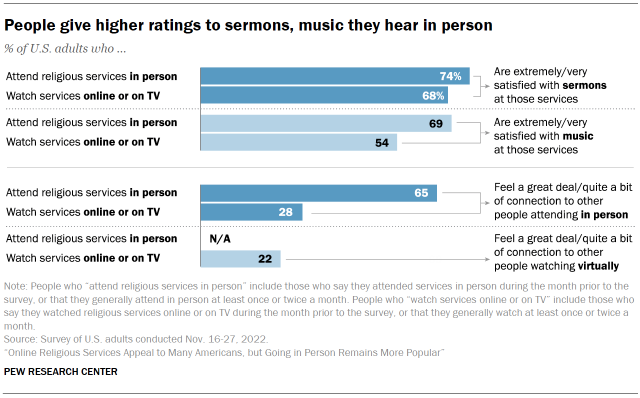
In addition, virtual viewers are much less likely to report feeling connected to other worshippers. Roughly two-thirds (65%) of regular in-person attenders say they feel “a great deal” or “quite a bit” of connection with their fellow attenders, the two highest options on a five-point scale.
By comparison, far fewer regular viewers – 28% – say they feel a strong connection with people who are attending a service in person while they, themselves, are watching on a screen. And 22% of virtual viewers say they feel strongly connected to the other people watching online or on TV.
Not everyone who watches services remotely feels fully engaged. A quarter of regular viewers say they usually feel they are an “active participant” in the service. But 32% say they feel they are watching “without truly being an active participant.” And 42% say they feel a little of both.
Pew Research Center surveys have shown that since early 2020, when the COVID-19 pandemic first struck the United States, the percentage of U.S. adults taking part in religious services in a given month – either in person, online/on TV, or both – has held remarkably steady, at about four-in-ten.
But as vaccines became widespread and the pandemic waned, the numbers attending in person rebounded and then plateaued, while the numbers watching on screens have declined.
In this report, “regular watchers” of religious services include everyone who says they watched services online or on TV in the month prior to the survey or that they generally watch at least once or twice a month. “Regular attenders” include everyone who says they attended services in person in the month prior to the survey or that they generally attend at least once or twice a month.
Here are the attendance numbers from the latest survey, as of November 2022:
- 16% of U.S. adults said they were regularly attending religious services only in person (and not online).
- 10% were regularly watching services only on screens (but not regularly going in person).
- 17% were regularly doing both.
In total, 43% reported that they generally attend and/or watch religious services at least once a month, or that they attended/watched services in the month prior to the survey.
A majority of U.S. adults (57%) said they do not generally attend religious services and did not do so in the past month, either in person or virtually.1
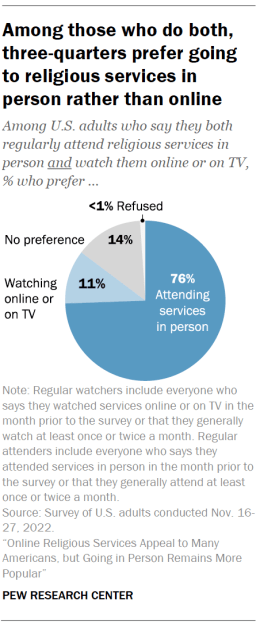
Looking at the numbers another way, the survey indicates that as the coronavirus pandemic winds down, about a quarter of Americans (27%) are still watching religious services on screens. This includes 10% who take part virtually but do not regularly attend in person, plus 17% who watch online or on TV and attend in person on a regular basis.
Those who do both – who watch services on screens and attend in person – overwhelmingly say they prefer going in person, by a margin of 76% to 11%. An additional 14% say they have no preference.
When asked why they watch religious services online or on TV, many regular viewers cite multiple reasons. But as the COVID-19 pandemic recedes, convenience is the most-commonly selected option – not fear of catching or spreading any illness.
Members of historically Black Protestant denominations are especially likely to be in the virtual audience for church services. While 13% of Protestants who belong to historically Black churches say they attend church in person and don’t regularly watch services virtually, most say they join services both in person and virtually (37%) or only watch remotely on screens (20%).
Part of the reason is continuing concern about COVID-19, which struck Black communities with particular force. The survey also shows that viewers who are members of historically Black Protestant churches are more likely to say they feel like active participants in these virtual services than are viewers who belong to some other faiths.
Survey respondents who said they watch religious services online or on TV were asked a follow-up question: Do they watch virtual services at the same congregation they typically attend in person, or do they sometimes go online/on TV to see services at other congregations, or both?
Among the 17% of U.S. adults who regularly do both things – attend worship services in person and watch them virtually – most say they watch services offered by a congregation other than, or in addition to, the one they typically attend in person. This represents 10% of all U.S. adults.
An additional 7% of U.S. adults say they sometimes attend in person and sometimes watch online/on TV, but they only watch services offered by the congregation they attend in person.
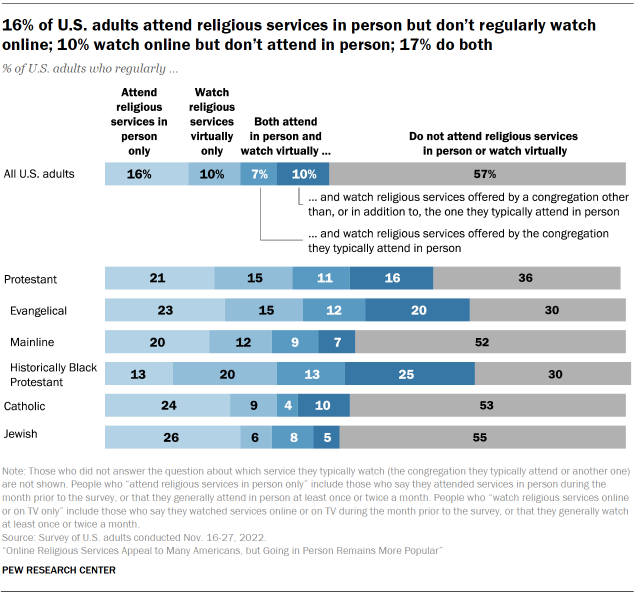
These are among the key findings of a new analysis of how Americans use technology in their religious lives, based on a Pew Research Center survey of 11,377 respondents conducted Nov. 16-27, 2022, on the Center’s nationally representative American Trends Panel. The Center previously published some findings from this survey.
A portrait of virtual worship
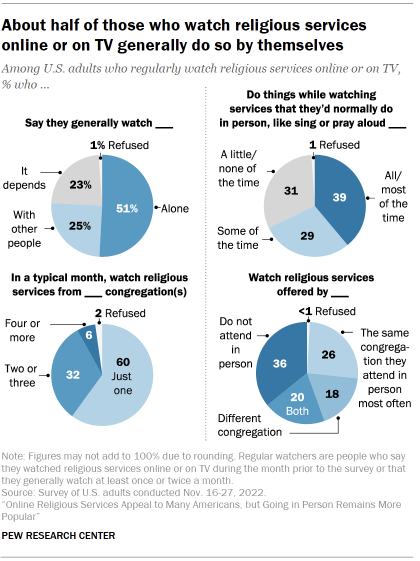
In stark contrast to the communal worship experience that churches and other houses of worship are known for – bringing people together in a building where they pray alongside each other – the experience of virtual worship is often a solitary one. About half (51%) of those who regularly watch religious services online or on TV say they generally watch these services alone. A quarter say they watch with other people, while another 23% say “it depends.”
Most regular viewers (61%) say that when they are watching services on a screen, they typically do not do things they would normally do when attending in person, such as praying out loud, singing or kneeling. For nearly four-in-ten virtual viewers (39%), though, the remote experience is similar to worshipping in person in ways such as these, all or most of the time. This is especially common among virtual worshippers who are Black (49%) and Hispanic (47%).
In addition, most virtual viewers (60%) watch services from just one house of worship, while 32% watch services from two or three congregations, and 6% watch services from four or more different congregations.
As for which congregations they watch, 26% of regular viewers say they exclusively watch services offered by the house of worship they generally attend. About one-in-five (18%) typically watch services offered by a different house of worship, while a similar share (20%) watch services of their own congregation and of other congregations. An additional 36% of regular viewers do not regularly attend religious services in person.
Read more about who watches religious services online or on TV, and their reasons.
Engaging with religion through technology
In addition to asking about virtual worship, the survey asked respondents whether they use online apps or web-based technology for religious purposes. Overall, three-in-ten U.S. adults say they go online to search for information about religion. Roughly one-in-five say they use apps or websites to help them read scripture or to remind them to do so, including 9% who do this daily. A similar share (20%) say they watch religion-focused online videos, such as those found on YouTube or TikTok.
Meanwhile, 15% of U.S. adults say they listen to religion-focused podcasts. A similar share (14%) say they use apps or websites to help or remind them to pray, including 8% who use prayer apps or sites daily. Fewer than one-in-ten (7%) say they participate online in prayer groups, Bible study groups or religious education programs.
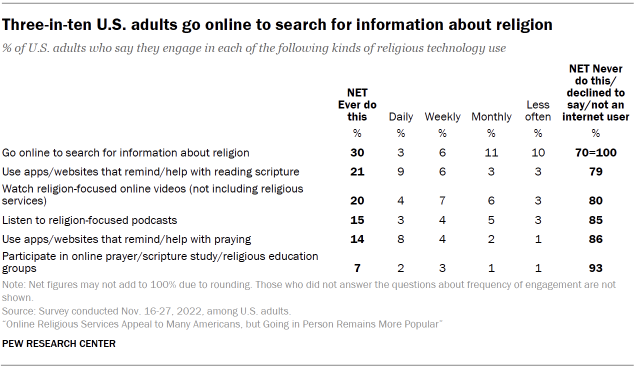
When these six questions are combined into an overall measure, four main groups of religious technology users emerge:
- 16% of U.S. adults can be categorized as “heavy users of religious technology” who engage weekly or more often in at least two of the six kinds of religious technology surveyed about.
- 10% of U.S. adults are “moderate users” who engage at least weekly in one kind of religious technology use.
- 20% of U.S. adults are “light users” who engage with religious technology online occasionally, but do not use any of the six religion-related technologies on a weekly basis (or more often).
- 54% of U.S. adults are “non-users” who never use prayer apps, consult scripture apps, watch religion-focused online videos, search for religious information online, listen to religious podcasts, or participate in online prayer/scripture study groups.
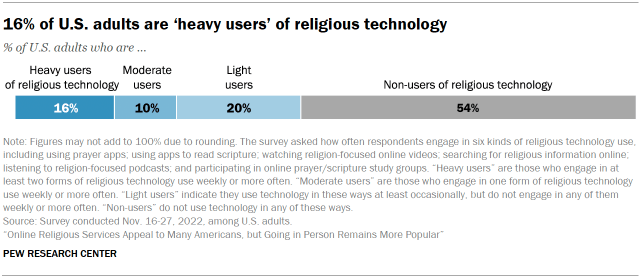
In general, adults in historically Black Protestant denominations (37%) and evangelical Protestants (28%) are more likely to be heavy users of religious technology than people in other major religious groups. Roughly one-in-ten Catholics, mainline Protestants and Jews are heavy users of religious technology (12% of each group).
For example, 47% of Americans in historically Black Protestant denominations and 39% of evangelicals use apps or websites that help or remind them to read the Bible or other scripture, compared with 18% of mainline Protestants and 15% each of Catholics and Jews.2 And 44% of those in the historically Black Protestant tradition and 38% of evangelicals watch religion-focused videos online, compared with 16% of Catholics, 15% of mainline Protestants and 14% of Jews. (Samples of other groups like Muslims, Buddhists and Hindus are too small to analyze, though members of these and many other faiths are included in the survey’s overall findings.)
Read more about the use of apps and websites for religious purposes.
Religion on social media
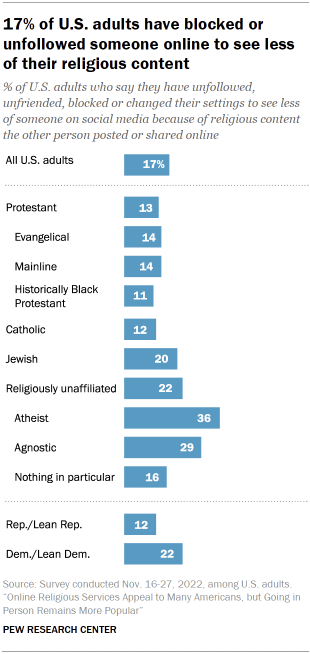
The survey also asked about social media usage, including how often respondents post or share content about religion online. Overall, 17% of U.S. adults say they post or share things about religion, including 2% who do this daily.
In addition, the survey asked, specifically, whether Americans post prayer requests online, including on social media sites. Roughly one-in-ten (11%) say they have posted a prayer request, while about four-in-ten (42%) have seen someone else’s prayer request online.
Meanwhile, 17% of Americans say they have unfollowed, unfriended or blocked a person on social media, or changed their social media settings to see less of a person, due to religious content they posted. And 3% say that someone else has done this to them online.
Atheists and agnostics are more likely than most other religious groups to say they have unfollowed others due to religious content. Democrats and independents who lean toward the Democratic Party are more likely than Republicans and Republican leaners to have unfollowed someone due to religious content on social media (22% vs. 12%).
Read more about the use of social media for religious purposes.
Differences in virtual worship by denomination
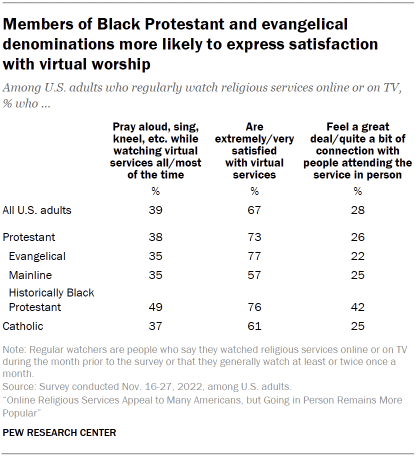
Americans who belong to historically Black Protestant denominations are more frequent watchers of religious services than the other U.S. religious groups with sample sizes large enough to analyze.
For example, about six-in-ten adults in historically Black Protestant denominations (58%) say they generally watch religious services on screens at least monthly or watched them in the month prior to the survey. This compares with 47% of evangelicals, 28% of mainline Protestants, 24% of Catholics and 19% of Jews.
Among regular viewers of religious services, those in historically Black Protestant denominations are also more likely to say they feel strong connections to in-person attenders at the services they are watching. In addition, members of historically Black Protestant churches (along with evangelicals) are more likely than Catholics and mainline Protestants to express high levels of satisfaction with virtual services in general.
Read more about who watches religious services online or on TV, and their reasons.
Differences in virtual worship by race and ethnicity
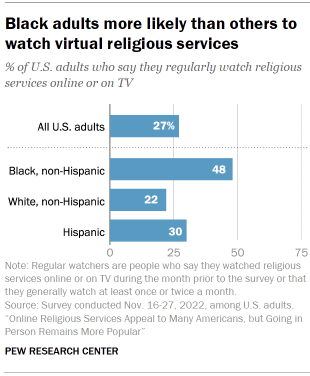
Irrespective of religious denomination, Black Americans stand out from people of other racial and ethnic backgrounds as generally more engaged with digital technology in their religious lives.
For example, 48% of Black adults say they watch religious services online or on TV at least monthly, or that they did so in the month prior to the survey. That is more than twice the share of White adults (22%) and higher than the share of Hispanic adults (30%) who regularly join religious services remotely.
In addition, Black adults are more likely than White or Hispanic adults to say they use apps that help or remind them to pray or to read scripture, and to say that they participate in online prayer groups, study groups and religious education programs. For example, roughly four-in-ten Black adults (41%) say they use an app to remind or help them to read scripture, compared with 25% of Hispanic adults and 17% of White adults who say they do this. And 32% of Black adults say they use an app to remind or help them to pray, compared with 20% of Hispanic adults and 10% of White adults.
Some of the heavy engagement by Black Americans may be related to their relatively higher levels of religious commitment in general. But even when the analysis is limited to Americans who are highly religious – i.e., those who attend services at least weekly, pray daily and say religion is very important in their lives – highly religious Black adults (54%) are more likely than highly religious White adults (38%) to be heavy users of religious technology.
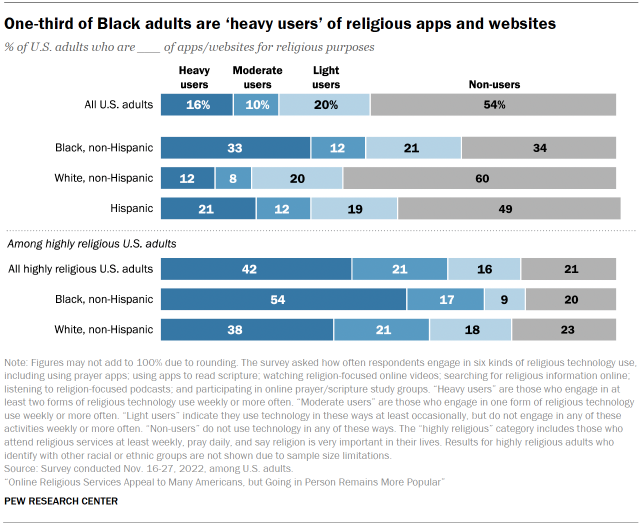
The survey also finds that Black and Hispanic virtual viewers are more likely than White viewers to say that while watching religious services they typically do things they would normally do if they were attending the service in person, such as praying out loud, singing and kneeling. Roughly half of Black (49%) and Hispanic (47%) adults who regularly watch services on screens say they do these things all or most of the time during virtual services, compared with 32% of White adults who regularly join religious services remotely.
Black and Hispanic adults who watch religious services regularly (33% each) are also more likely than White adults (18%) to say they usually feel like an active participant during virtual religious services.
Age differences in the use of technology for religious purposes
Overall, there are modest differences between younger and older adults in the general population when it comes to use of technology for religious purposes. Among Americans 65 and older, 13% are heavy users of religious technology, which is slightly lower than the shares of heavy users among those ages 50 to 64 (16%), ages 40 to 49 (18%) and ages 18 to 39 (16%).
That said, links between religion and technology use are complicated. Given that older people tend to be more religious than younger people, they might be expected to use religious technologies more. But it’s also true that older people are generally less likely than younger people to use technology in general. So, to get a better sense of the relationship between age and religious technology use, we analyzed the habits of only highly religious people (those who pray daily, attend religious services weekly and say religion is very important in their lives), on the grounds that they might be more inclined than other Americans to use religious technology in the first place. Looking at it this way, the age differences are more obvious. Half of highly religious Americans under 50 are heavy users of religious technology, compared with about a third of highly religious Americans ages 65 and older.
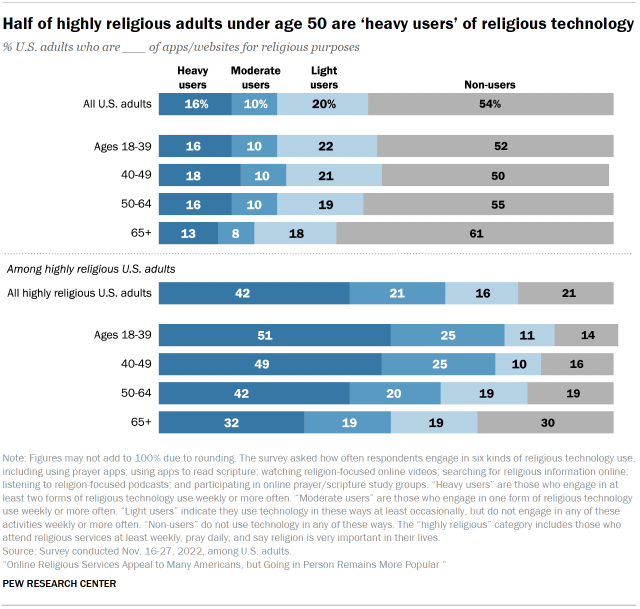
Motivations for virtual viewing and for attending in person less often
There is no single reason why virtual religious services appeal to many Americans. When asked why they tune in, regular viewers tend to give multiple answers. But of six possible reasons offered in the survey, the most commonly chosen is convenience. More than four-in-ten regular watchers (43%) say convenience is a major reason they watch services on screens. The next most-cited major reason is being able to watch services that are far from their home (34% say this).
With the height of the pandemic in the rearview mirror when the survey was conducted, personal health and safety – meaning, not having to worry about catching or spreading COVID-19 or other illnesses – is tied for the third most-cited major reason for watching services online or on TV, cited by 25%. That same share says this about being able to keep up with congregations to which they previously belonged.
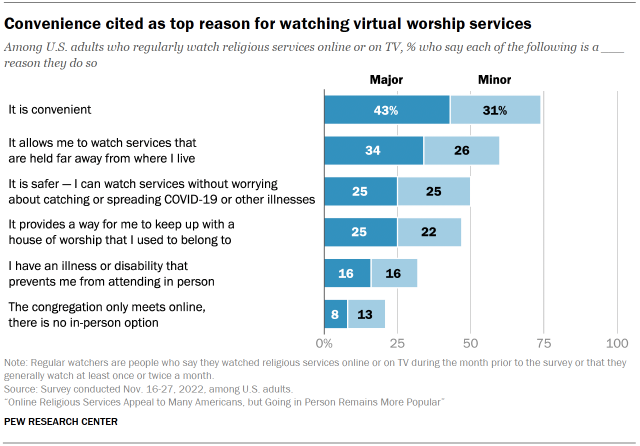
Fewer regular viewers cite illness or disability (16%) or their congregation’s lack of an in-person option (8%) as a major reason they regularly watch religious services.
Additional viewers cite these as minor reasons for watching services online. In sum, around three-quarters of viewers (74%) say convenience is either a major or minor reason for viewing services virtually, while six-in-ten say this about getting to watch services held far from where they live. Roughly half say personal safety (49%) or being able to keep up with congregations they once belonged to (48%) is either a major or minor reason for watching online.
A corresponding set of questions asked about the reasons why some Americans attend in-person worship services less often than they did before the pandemic. (One-in-five U.S. adults say they attend religious services in person less often now than prior to the COVID-19 outbreak.)
The two most-cited reasons for less frequent attendance are the development of other spiritual interests and a continued concern about COVID-19. About one-fifth of less frequent attenders (21%) say they go to religious services less often now because they found other ways to pursue their spiritual interests, and a similar share say they go less often because they are still worried about COVID-19.
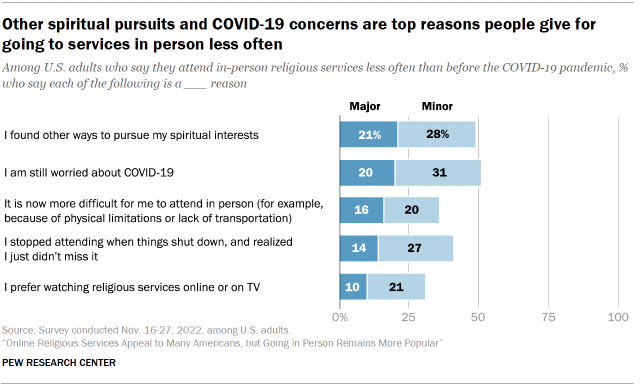
Slightly lower shares say a major reason they now attend in person less often is that there are personal difficulties related to in-person attendance (16%), they realized after the shutdown that they didn’t miss in-person attendance (14%), and that they prefer watching services online or on TV (10%).
Overall, about half of less-frequent attenders cite worries about COVID-19 or the pursuit of other spiritual interests as either a major or minor reason they attend less often now than they did prior to the pandemic.
The rest of this report explores the survey findings in more detail.




